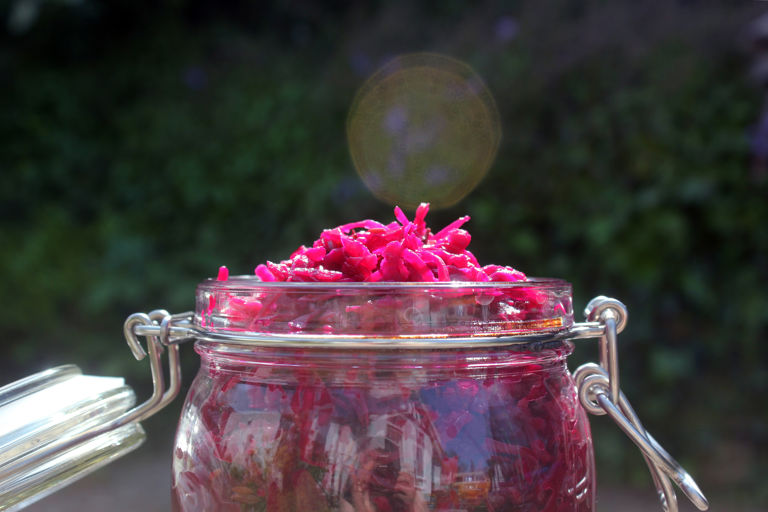Beetroot sauerkraut
This beetroot sauerkraut recipe from Chloë King offers a colourful twist to the classic German version, which is made entirely of white cabbage. The world of wild fermentation may seem intimidating initially, but once you've taken the plunge into this world of yeasty delights, you'll be hooked. Use the beetroot kraut to add burst of vibrant flavour to summer barbecues, salads or charcuterie plates.
It has become so much the ‘in thing’, that mere mention of fermentation to seasoned foodies provokes replies like, ‘yeah yeah, I’ve been reading Sandor Katz in bed since 2012. I know all there is to know.’ Either that, or they’ll just issue a knowing look before dropping in nonchalantly, ‘no fizz: no flavour’.
For most of us, however, wild fermentation remains a bit of a scary unknown. On a basic level, the process involves preserving vegetables in salt to let natural yeasts and beneficial probiotics (lactic-acid bacteria) multiply and, as if by magic, transform sugars into B-vitamins, fatty acids and helpful enzymes.
The process creates pickles with a long shelf life that are good for digestion, rich in umami flavour, and a pleasing addition to salads, or accompaniment to, among other things, barbecued meat and fish. In spite of its novelty, wild fermentation is also something we have been doing for donkeys – before the arrival of fridge freezers and industrial food processing took away the necessity to preserve foods at home.
As with many of the best things, I learnt fermentation from a friend. Ana Frearson of Cultured Kitchen sells her homemade krauts, kimchi, kombucha and kefir (all the K’s) at my local market and she has a real passion for fermentation, something she describes as being more about ‘getting in touch with nature’ than ‘making a tasty pickle’.
Fortunately, or unfortunately, for a recipe writer, the business of making ferments is not an exact science. As its name suggests, wild fermentation utilises microorganisms that are naturally present in our environment. The exact qualities, and balance of these will vary according to where, when and who by the pickle is made. As these cultures affect flavour, Ana says don’t worry too much about the precision of your recipe. Instead, she says, just ‘bring on the bacteria’.
For this colourful beetroot kraut I have followed the golden ratio of 1.5tsp-2tsp of salt per 500g of vegetables. To make traditional German-style sauerkraut you could just as well omit the beetroot, replacing it with extra cabbage. I taste the ferments regularly as they develop over days and weeks. When happy with the flavour depth, I pop them in the fridge to pep-up salads, sandwiches, grilled meats and fish.
Beetroot kraut works beautifully with smoked meats and sausages and is a welcome addition to a summer salad with toasted seeds and soft goat's cheese.
This recipe makes enough for one 500g jar.
Ingredients
Metric
Imperial
Beetroot sauerkraut
- 200g of beetroot, grated
- 300g of white cabbage, finely sliced
- 1 tsp caraway seeds
- 1 tsp fennel seeds
- 2 tsp sea salt, such as Maldon or Halen Môn
Method
Get in touch
Please sign in or register to send a comment to Great British Chefs.



